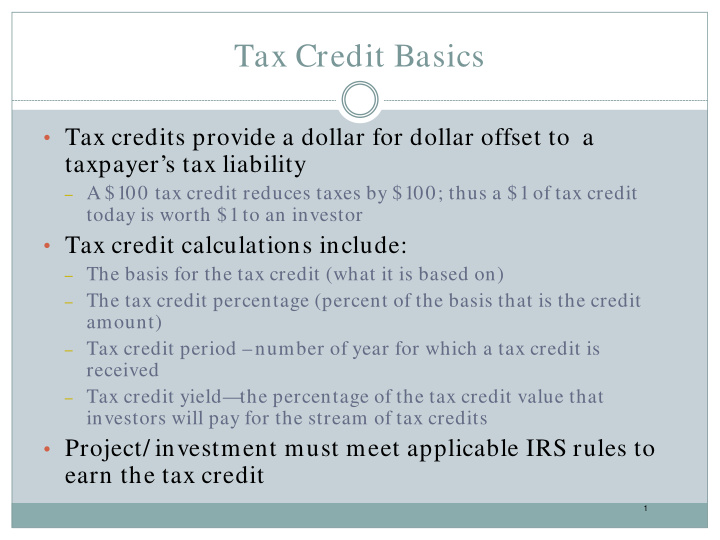



Tax Credit Basics • Tax credits provide a dollar for dollar offset to a taxpayer’s tax liability – A $100 tax credit reduces taxes by $100; thus a $1 of tax credit today is worth $1 to an investor • Tax credit calculations include: – The basis for the tax credit (what it is based on) – The tax credit percentage (percent of the basis that is the credit amount) – Tax credit period –number of year for which a tax credit is received – Tax credit yield—the percentage of the tax credit value that investors will pay for the stream of tax credits • Project/ investment must meet applicable IRS rules to earn the tax credit 1
Low-income Housing Tax Credit • Project must develop new low-income housing • Basis is the depreciable investment in the project • Credit is 9% or 4% of depreciable investment; depends on use of other federal subsidies, % of low- income units and other requirements • Credit period is 10 years – Investor gets the 9% or 4% credit for 10 years 2
New Market Tax Credit Project must invest via a CDE in a qualified business in a low-income area Basis is the CDE’s investment in the qualified business Tax credit amount is 39% (5% for first 3 years and 6% for next 4 years) Tax credit period is 7 years 3
Historic Investment Project must be a substantial investment to rehabilitate a historic property in accordance with Secretary’s standards Tax credit basis is the rehabilitation investment in the building and related soft costs over a 24 month or 60 month period Tax credit is 20% of the basis: 5% a year over four years Tax credit period is four years 4
Parties to Tax Credit Investment Project developer or owner Tax credit investor Tax credit syndicator or intermediary Lawyers and accountants with tax credit expertise Other lenders and funders 5
MIT OpenCourseWare https://ocw.mit.edu 1 1.437 Financing Economic Development Fall 201 6 For information about citing these materials or our Terms of Use, visit: https://ocw.mit.edu/terms.
Recommend
More recommend